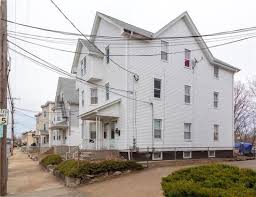
As much of the northern hemisphere starts to cool down from a historic heatwave, there’s a residual climate anxiety in the air. From coast to coast, most communities must modify their habits, homes, and neighborhood infrastructure to meet the crushing demands of extreme heat. Hotter days– this will be the coolest summer on record for at least the next four generations – will inevitably lead to more heat-related illnesses and hospital visits and this burden won’t be shared equally. The most heat-vulnerable communities are home to people of color, immigrants, and low-income families.
But why? What leads to shadeless streets like the one pictured and what can we do about it?
Due to a history of race-based housing discrimination, the most common of which was redlining – the practice of ranking neighborhood quality based on the race and income of residents – black and brown neighborhoods were often denied municipal and private investments in trees, greenspaces, and other infrastructure that would reduce the impact of extreme heat. Climate adaptation infrastructure including tree planting, shade structures, depaving lots and yards, green roofs, and green spaces are important tools in our climate adaptation toolkit. Investments in these solutions are important, but we must learn from our past and ensure that infrastructure isn’t prioritized above people.
The pursuit of climate justice requires us to approach urban cooling in new ways. We need to develop a people-centered approach that centers the perspectives of those living in the community. Through our Climate Safe Neighborhoods partnership – a thirteen-city partnership to address the inequitable impact of climate-related extreme heat and flooding – we have developed an approach to building community members’ capacity to define and lead change.
We’ve found that our most successful efforts incorporate three practices.
- Start with the why.
Urban heat is not new and communities have long asked for changes that would make their neighborhoods safer and healthier. Before we can identify solutions, we need to start by asking, “why hasn’t change happened yet?” We need to understand the systems and structures that have left some neighborhoods hotter and more vulnerable to flooding than their neighbors. Through the Climate Safe Neighborhoods partnership, we dig into how the legacy of place-based housing segregation has shaped communities. By looking backward, we can explore questions such as:-Why do our communities look the way they do?
-What is different about cooler neighborhoods?
-How are resources distributed across neighborhoods?
-Who is making resource decisions?Through this holistic approach, we can design strategies and solutions that not only provide short-term relief but change the very systems that have perpetuated harm and lay the foundation for a more just future. - Provide residents with the tools to make decisions about their future.
Climate adaptation is not a one size fits all effort and the people living in climate-vulnerable neighborhoods should decide the future of their communities. Often decisions about climate infrastructure rely on complex data analysis and mapping that is presented to community members as justification for predetermined solutions. Through the Climate Safe Neighborhoods partnership, we put decision-making tools directly in the hands of residents. Through the creation of climate adaptation dashboards, we visualize the connection between the environment (pavement, buildings, trees, parks, waterways) and health, heat, and flooding risks.We provide training so that community members are able to review, analyze, and interpret the data themselves and explore the questions most relevant to their day-to-day lives. By putting residents in the driver’s seat, they can couple the data with their lived experience – creating a clear and actionable picture of what they need. These details inform better decision-making and can focus infrastructure investments on where they will have the greatest impact on people’s lives. - Expand the definition of cooling infrastructure.
Heat isn’t felt in insolation in urban communities. When we dive into the climate dashboards, it is easy to see that the hottest neighborhoods are often those with the lowest incomes, the least outdoor greenspace, and the highest risk of flooding. Commute times are long and often spent waiting at unshaded bus stops or on pedaling down sunny roads on bikes. When given the tools to imagine a safer future, community members come up with innovative and creative solutions that meet multiple interconnected needs. For example, in New Bedford, MA, in a heat and flood vulnerable neighborhood with a significant food insecure community, residents prioritized the creation of a community garden so that residents had a safe space to get outdoors next to the river to grow fresh produce. The Urban Farm now serves as the heart of a “resilience” zone – a site for multiple complementary climate resilience actions.
Through these efforts, we are demonstrating that a community-driven urban cooling strategy is not only possible – it’s more sustainable and impactful. As extreme heat continues to make headlines, it’s essential that we approach this challenge from a people-centered lens and invest in those on the frontlines to build safer, healthier, and cooler urban neighborhoods.
If you’re interested in taking action in your community, but don’t know how to get started, you can learn more about our approach in our recently published Taking Action Guide. The guide shares key elements from our work and provides tools to help you integrate these strategies in your own neighborhood so that we can expand the community of practitioners implementing an equity-centered approach to a climate safe future.
-Cate Mingoya-LaFortune
National Director of Climate Resilience and Land Use
